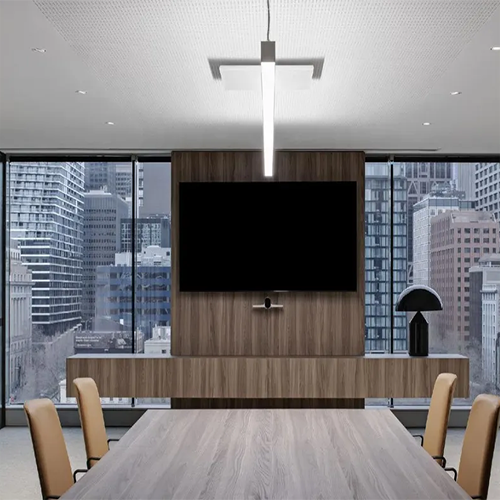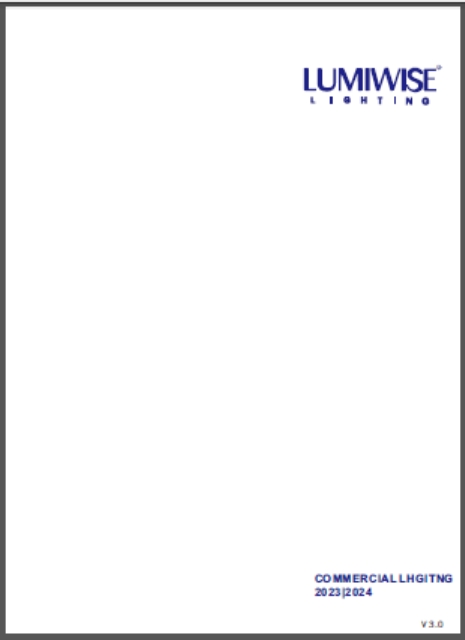Why LED luminaire with UGR<19 Still has glare?
—— Your Calculated UGR Values Might Be Wrong All Along!
When make lighting design, UGR<19 has been widely regarded as the reference upper limit for glare control.
However, the UGR values output by most current design software are not the “applied UGR” (UGRAppl) recognized by CIE standards.
This article will systematically sort out the classification, standard basis, and common misunderstandings of UGR to help designers accurately understand and correctly use UGR.
1. UGR<19 Does Not Mean No Glare
UGR (Unified Glare Rating) is one of the key indicators used to evaluate discomfort glare in indoor lighting design. In most projects, “UGR<19” has become synonymous with comfortable lighting. However, most designers and suppliers involved in calculations and analyses are unaware that:
The default UGR values output by most software currently do not conform to the UGRAppl defined by CIE standards, but are UGRPoint; and the UGRLum marked in many lamp specifications cannot represent the actual glare level of the space.
2. Origin and Basic Principles of UGR
UGR was first proposed by the International Commission on Illumination (CIE) in CIE 117:1995 and expanded in the subsequent CIE 190:2010. It is an empirical formula for quantitatively evaluating glare caused by indoor artificial lighting.
Its basic calculation formula is as follows:
UR=00Σ [formula omitted]
Where:
- Ls: Luminance of the light source in the observation direction;
- Ω: Solid angle of the luminaire at the viewpoint;
- p: Position index (Guth Index), reflecting the relationship between the luminaire and the line of sight angle;
- Lb: Background luminance, excluding direct light from the luminaire.
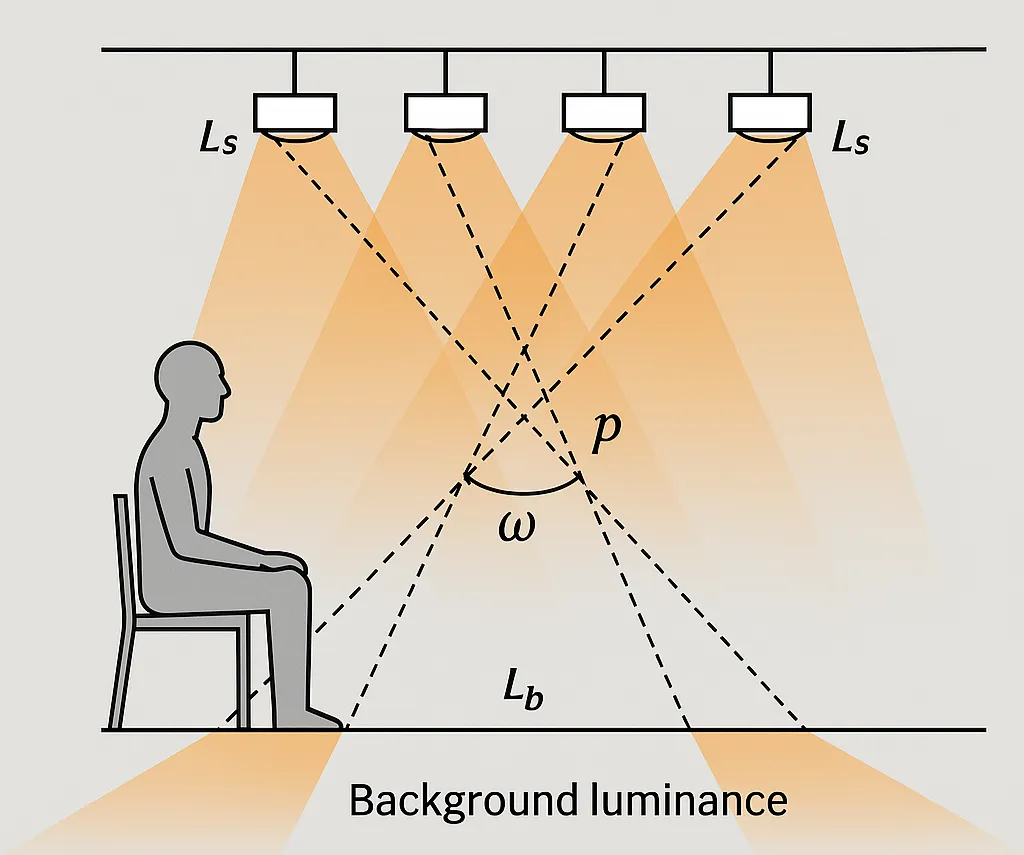
3. Three Types of UGR and Their Differences
There are three common forms of UGR in practical applications:
| Type | Source | Definition | Can it be used to judge UGR<19? |
| UGRAppl | CIE standard method | Index on average after simulating real space, viewing angle, and reflectivity in the 1H×1H area | Yes, the only recommended one |
| UGRLum | Luminaire manufacturers’ data | Simulated UGR value of luminaires under standard room conditions, used to compare glare tendencies of different luminaires | Referenceable, but cannot be used for actual space judgment |
| UGRPoint | Software default output | Instantaneous UGR value at a specified observation point and direction, easily affected by viewing angle and local conditions | Prohibited from being directly used as a basis for design judgment |
Note: Both CIE and NEMA point out that UGRPoint cannot represent the overall visual comfort of the space, nor can it be used to determine whether UGR is less than 19.
4. Definitions and Misunderstanding Clarification of UGRAppl, UGRLum, and UGRPoint
UGRAppl: Application UGR
Source: CIE 190:2010, NEMA LS 20001
Calculation method: Collect multiple UGR point values in two “1H×1H” areas (the center of the long side and short side of the room);
Use the formula: UGRAppl = 8log₁₀ (average(10^(UGR/8)))
Features: Considers key factors such as space reflectivity, luminaire layout, and observation direction.
Purpose: The only standard method that can be used to determine whether the space UGR<19.
UGRLum: Luminaire UGR
Source: Luminaire manufacturers
Conditions: Standard 4H×8H space, 70/50/20 reflectivity, equidistant lamp arrangement, fixed viewpoint.
Advantages: Facilitates quick comparison of the glare control capabilities of the luminaires themselves.
Limitations: Cannot reflect the UGR performance of multiple lamp combinations or complex viewing angles in the actual space.
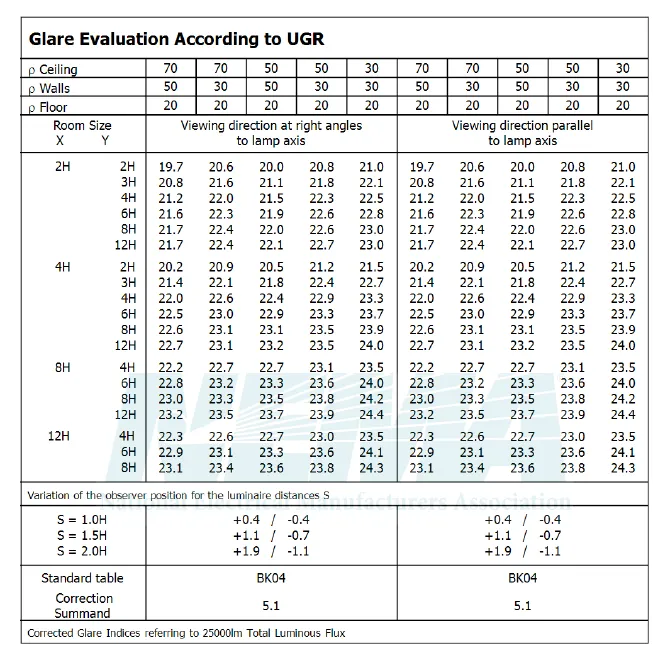
[Figure: UGR table for a single lamp (from NEMA white paper)]
UGRPoint: Pointwise UGR
Source: Default output of design software
Description: Only reflects the instantaneous UGR value of a certain observation point in a specific direction.
Disadvantages: Easily affected by local geometry, occlusion, and reflective surfaces, and cannot be used for global judgment.
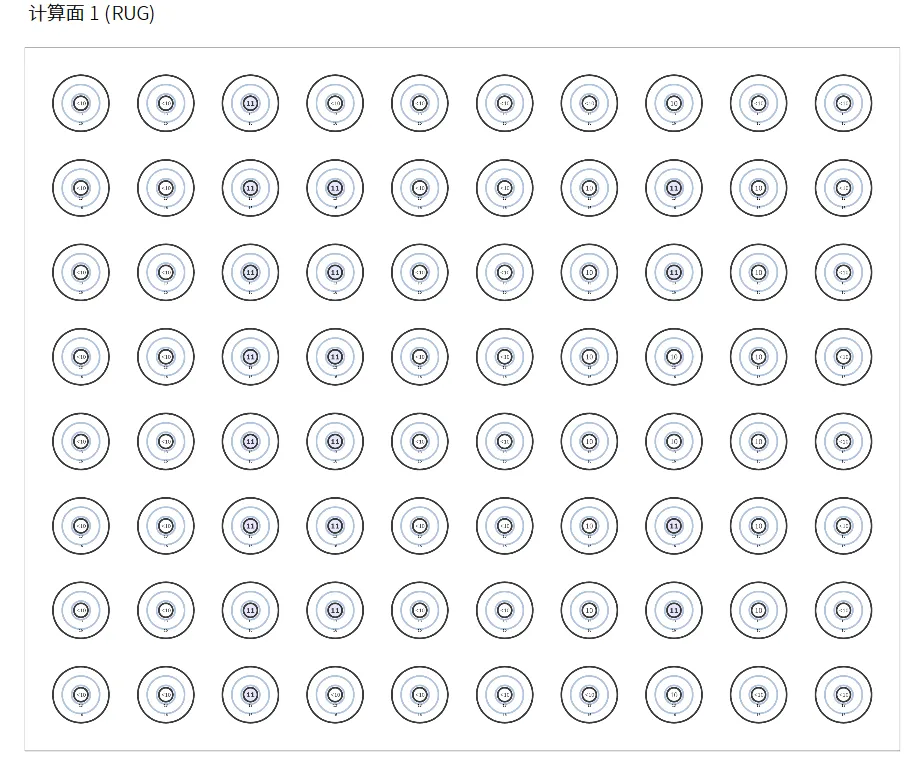
[Figure: UGR calculated by DIALux evo, taking the maximum value]
5. How to Accurately Calculate UGRAppl?
UGRAppl is the only glare evaluation method recognized by CIE standards in lighting design. Its calculation process is as follows:
Step 1: Establish a realistic space model
Accurately draw the room’s geometric structure;
Set the reflectivity of the ceiling, walls, and ground (e.g., 70%/50%/20%);
The luminaire model must truly reflect the installation height, shielding angle, light distribution, etc.
Step 2: Set two standard observation areas
Place 1H×1H observation rectangles at the midpoints of the long and short sides of the room respectively;
Set the human eye viewpoint at a height of 1.2m, looking horizontally at the opposite wall;
Arrange multiple UGR calculation points in each area (it is recommended to use a grid of ≤0.5m).

[Figure from NEMA white paper]
Step 3: Calculate UGRAppl
Record the UGR values of all observation points;
Substitute each UGR value into the formula: 10^(UGR/8), and find the average;
Take the log₁₀ of the average and multiply by 8 to get the UGRAppl of the area;
The larger value of the two observation areas is the final UGRAppl of the space.
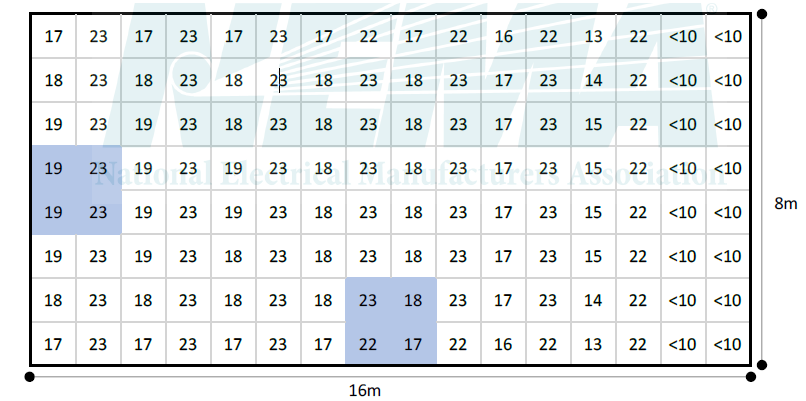
[Figure from NEMA white paper]
Tip: UGRAppl must be calculated by the exponential averaging method, and cannot directly use the maximum or simple average of UGRPoint.
6. How Do Luminaire Structure and Light Distribution Affect UGR Perception?
Shielding Angle and Visible Light Source Control
The shielding angle refers to the angle from the horizontal direction of the observation point to the shielding edge of the luminaire. It does not directly participate in UGR calculation, but is crucial for controlling whether the human eye can directly see the high-brightness light-emitting surface, and is a key structural parameter affecting perceived glare.
The larger the shielding angle, the harder it is for the light source to enter the line of sight, and the weaker the glare sensation;
When the shielding angle is <20°, the human eye can easily look directly at the light source, resulting in a high risk of glare;
It is usually recommended that the shielding angle be ≥30°, which is the design lower limit for office, teaching, medical and other spaces.
| Space Type | Recommended Minimum Shielding Angle | Application Description |
| Office Space | ≥30° | Avoid line of sight penetration when sitting or looking up |
| Classroom/Meeting Area | ≥35° | Control glare from students’ / audiences’ head elevation angles |
| Medical Places | ≥40° | High visual requirements, prevent glare when patients look up |
| Exhibition and Retail | ≥25° | Concentrated lighting while considering shielding |
Engineering suggestion: Prefer luminaires with deep cup reflectors, honeycomb grids, black mirror covers or light-shielding frames to improve shielding performance and optimize visual experience.
7. Qualified UGR Value ≠ Visual Comfort
1. Impact of Human Eye Adaptability on UGR Perception
Dark background → strong contrast → increased glare perception;
The same UGR value is perceived weaker in a bright space.
2. Deviations Caused by Fluctuations in Line of Sight Direction
In actual use, the direction of the line of sight is not fixed, and looking up or low-angle observation will increase the actual discomfort.
3. Large Individual Differences in Perception
Elderly people, amblyopic people, and people with high visual task requirements are more sensitive to glare.
4. Recommended Combined Use of Other Indicators
- VCP (Visual Comfort Probability);
- DGP (Daylight Glare Probability);
- UGR heat map to assist in visual distribution analysis.
8. Truly Comfortable Lighting is More Than “UGR<19”
UGR is a useful tool, but not everything. Truly comfortable lighting is a comprehensive grasp of five aspects: light intensity, light direction, background, behavior, and perception.
UGRAppl is the standard value for judging compliance and cannot be replaced by UGRPoint, nor can UGRLum be applied to actual projects. Design work should not only “seem qualified” but also “be comfortable to use”.
The original intention of the UGR indicator is to help designers control indoor discomfort glare, and its significance should not be simply equated with “UGR<19 = no glare”. Only by analyzing UGR in the context of the overall relationship between space functions, human eye behavior, luminaire design, and the light environment can its evaluation role be fully exerted.
In the future, with the continuous development of AI-assisted design, behavior perception technology, and human-centered lighting models, UGR may work with emerging evaluation mechanisms such as VCP and DGP to build a more complete comfort evaluation system.
UGR is not the end, but the starting point for moving towards scientific lighting design.



Recommended References:
- CIE 117:1995 — Discomfort Glare in Interior Lighting
- CIE 190:2010 — Calculation and Presentation of UGR
- CIE 232:2019 — Discomfort Glare from Non-Uniform Luminaires
- CIE TN 014:2023 — HDR Imaging in UGR Assessment
- NEMA LS 20001:2021 — Unified Glare Rating White Paper
- ISO 8995-1 / EN 12464-1 — Lighting of Indoor Work Places

